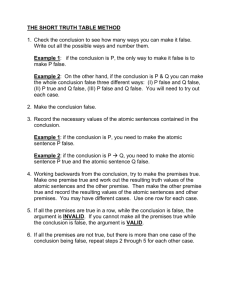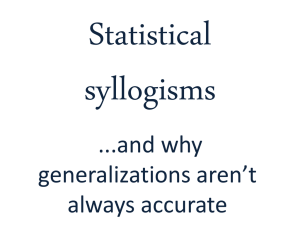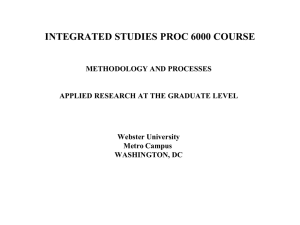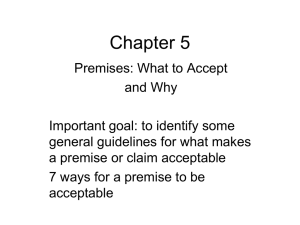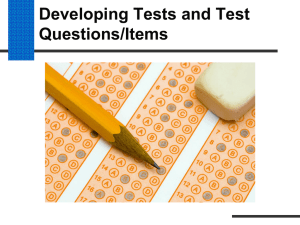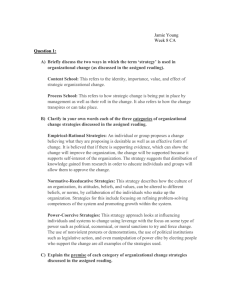The Short Truth Table Method
advertisement
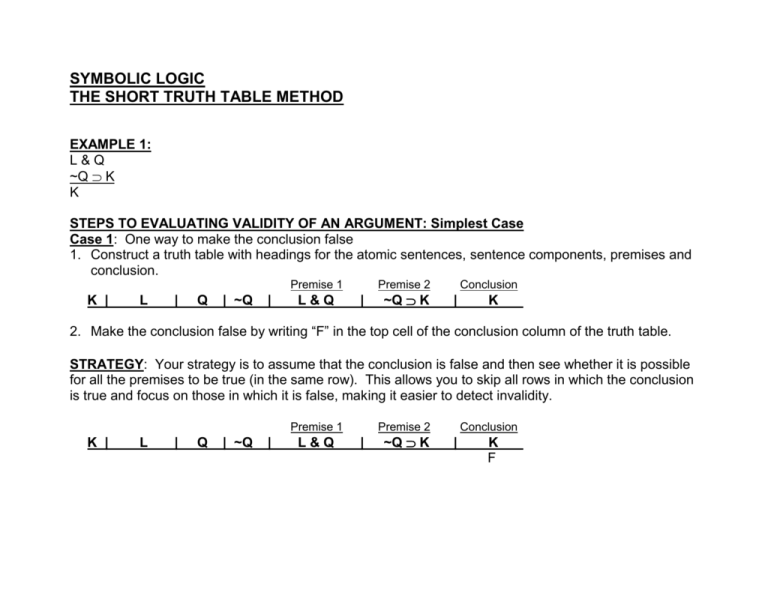
SYMBOLIC LOGIC THE SHORT TRUTH TABLE METHOD EXAMPLE 1: L&Q ~Q K K STEPS TO EVALUATING VALIDITY OF AN ARGUMENT: Simplest Case Case 1: One way to make the conclusion false 1. Construct a truth table with headings for the atomic sentences, sentence components, premises and conclusion. Premise 1 K | L | Q | ~Q | L&Q Premise 2 | ~Q K Conclusion | K 2. Make the conclusion false by writing “F” in the top cell of the conclusion column of the truth table. STRATEGY: Your strategy is to assume that the conclusion is false and then see whether it is possible for all the premises to be true (in the same row). This allows you to skip all rows in which the conclusion is true and focus on those in which it is false, making it easier to detect invalidity. Premise 1 K | L | Q | ~Q | L&Q Premise 2 | ~Q K Conclusion | K F 3. Since there is only one way to make this conclusion to be false is K to be false, you will probably only need one row to check validity. If there is more than one possible truth value assignment that would make a conclusion false, skip to the next series of steps. 4. Given that the conclusion is false, see what follows about the truth values of the letters that make up the conclusion. For example, the only way the conclusion “K” can be false, is if the atomic sentence “K” is false, so write F under the appropriate atomic heading. Premise 1 K | F L | Q | ~Q | L&Q Premise 2 | ~Q K Conclusion | K F 5. Now you want to try to make all the premises true, so look for which premise is hardest to make true. For example, the only way to make Premise 1 true is for both L and Q to be true. Put a T under Premise 1. 6. If making the first premise true tells you the truth values of the atomic sentences or compound sentences it contains, write these truth values down on the left side of the table. For example, to make Premise 1 true, you had to make L and Q true, so write a T under each of the headings for these atomic sentences. Premise 1 K F | L T | Q T | ~Q | L&Q T Premise 2 | ~Q K Conclusion | K F 7. If the truth values of this atomic sentence determines the truth value of any of the compound sentences, write it down. In Example1, ~Q must be F since Q is T. Premise 1 K F | L T | Q T | ~Q F | L&Q T Premise 2 | ~Q K Conclusion | K F 8. Look at the next premise. If its truth value can be calculated based on what you already know, write it down. For example, if ~Q is F and K is F, then the truth value of Premise 2 is T, so write it down. Premise 1 K F | L T | Q T | ~Q F | L&Q T Premise 2 | ~Q K T Conclusion | K F 9. If there are more premises, repeat Steps 6 and 7 until you have filled in all truth values for all premises. 10. If you have made all premises true, the argument is INVALID, since you have shown it is possible for the conclusion to be false when all premises are true. If you have one false premise, repeat Steps 59, starting with a different premise, and see whether you can make all premises true this way.
